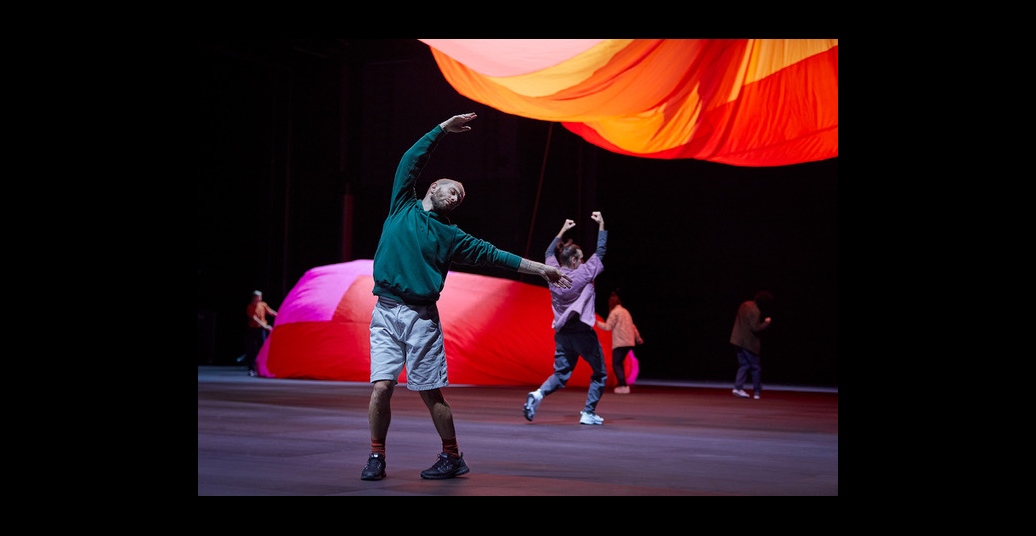With “Magenta Haze,” Milla Koistinen investigates the behavior of individuals within a collective, as well as communal ecstasy and shared joy. As part of the :LOVE: collaboration between Tanzfabrik and Radialsystem, the work has its German premiere at Radialsystem from 2 – 4 March 2023.
Once again, Berlin showed its worst side this January and February. We’re all probably more than ready for some sun, light, and color.
No wonder the sea of colors spread over the large and in this case chair-less Radialsystem performance space feels so overwhelming. Brightly colored in red, orange, pink, lilac, blue, and green, three huge swaths of fabric spread out, suspended with ropes from the ceiling or filled with air as giant movable balloons (objects: Sandra E. Blatterer, scenic design/light: Michele Piazzi). Eight dancers — Raul Aranha, Simon Chatelain, Fanny Didelot, Milla Koistinen, Jin Lee, Elise Ludinard, Nitsan Margaliot, Angelo Petracca — walk through the space, constantly in motion, (re-)arranging themselves and the balloonlike objects; the audience is invited to move with them throughout the room.
In “Magenta Haze,” Milla Koistinen works with an impressively clear formal language on the border between dance and visual art, with strong collages made of bodies, space, sound, and objects and with finely elaborated movement qualities. The dancers, dressed in sneakers, jeans, and shirts in subdued colors (costumes: Jin Lee), move through different physical images and poses, guiding their torsos gently into one freeze moment after another as they walk, their arms extended relaxed but with purpose in the air, hands and fingers drawing imaginary axes. Toggling between slow and fast, their bodies drift through the room as if running at high speed and at the same time moving in slow motion through a thick substance. They position themselves in relation to the rest of the group, to the audience, and to the balloon-shaped fabric objects that they are collectively and constantly rearranging. The objects become co-performers in the process, with changing forms — sometimes they are imposing balloons, sometimes bright clouds, sometimes colorful animal beings.
The dancers form a swarm, the balloons fly, everything is bathed in pink, purple, orange, red, blue, and green. The rousing sound (Grégoire Simon and Paul Valikoski) grows more complex, the music’s beat swells, the dancers’ tempo reaches a peak: faster and faster they drag and herd the huge objects around. The eruptions of the dancers’ upper bodies flood through the space, partly spreading to audience members — I see a sea of bobbing heads, the room throbs. The scene builds and builds, to an ecstatic moment: the eight bodies gather in a cluster in the middle of the space, create wild formations in dirty unison, throw their arms in the air, bouncing their torsos explosively, fog, red light, colorful sea of colors, techno beat, club atmosphere.
“Magenta Haze” is an extension of Milla Koistinen’s research on the individual within the collective body, and communal joy and ecstasy. Ecstasy as a condition that pulls us out of ourselves and transports us into an elsewhere has traditionally held a critical position in dance. Mary Wigman used her spinning dances to formulate a critique of existing conditions; more recent works tend to take a critical view of ecstatic phenomena as a solution for society’s problems, and in rave culture, the body is caught between the solidarity of the commons and capitalistic isolation. The ambiguity of ecstasy and its representations (is it part of the solution or part of the problem?) can, depending on the choreographic treatment, also pose a challenge for the audience.
But “Magenta Haze” manages to create this space of being-outside-oneself — of which the audience is a natural part — in a way that’s pleasantly unobtrusive, with a fresh, consistent, affirmative formal language. And so I imagine, feeling the beat in my limbs and watching the pulsing bodies of the dancers and the bobbing heads, that a collective experience is becoming tangible here.
When I leave the space, I see smiling, relaxed faces.
Everyone is really ready for spring.
English translation by Cory Tamler
„Magenta Haze“ by Milla Koistinen (world premiere 27.10.2022 at Dance House Helsinki) will be presented as German premiere at Radialsystem from 2 – 4 March 2023 as part of the :LOVE: collaboration between Tanzfabrik and Radialsystem.




